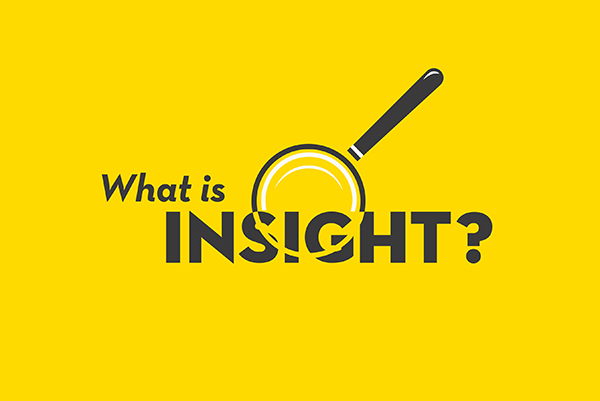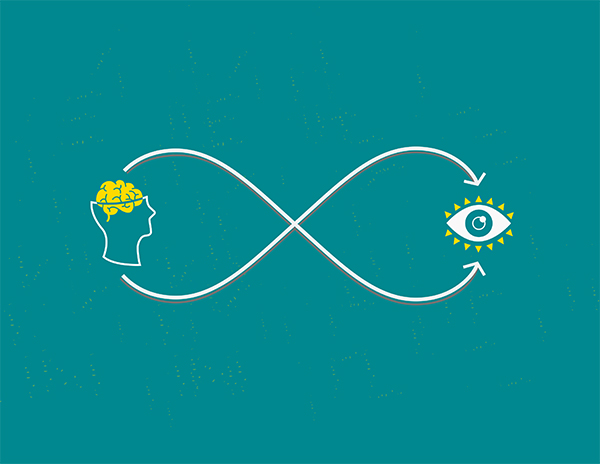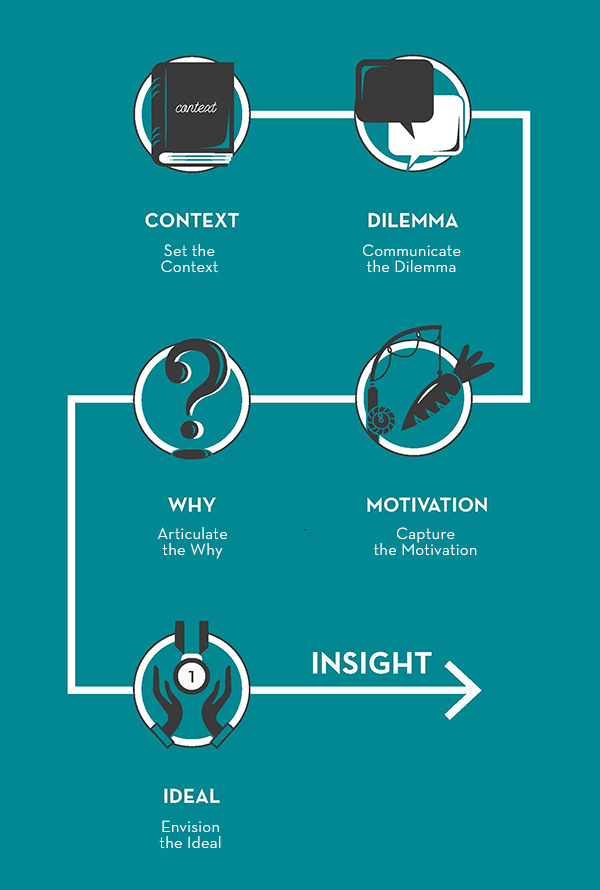What Is Insight? The Five Principles of Effective Insight Definition
At THRIVE, our team understands that as customer experiences take center stage, so does the need for a more profound and compelling insight definition. Consumer insights form the cornerstone of the design and innovation process, a lighthouse for what you should do next, and a catalyst for creating new value for your customers.
The ever-increasing explosion of data puts more knowledge at our fingertips than ever before, but you need to know what to do with it. Otherwise, it is obsolete and ineffective. We see an increasing lack of insight with companies living in an “illusion of knowledge,” drowning in data, insight poor, and failing to turn information into intelligence. Why?
One reason is the lack of a shared definition of insight and a common understanding of what insight definition is and is not. An absence of the methodological rigor required for meaningful insight generation to happen is another. Organizations frequently struggle to arrive at a standard insight definition and a repeatable methodology for finding and articulating it.
Trial-and-error prevails, with insight definition relying on eureka moments for sudden key consumer insights and perspective. Unfortunately, most ‘new consumer insights’ we see are nothing more than mere observations of a user experience, reporting what has been seen in-field without any overt action or outcome attached. If we do not clearly understand what ‘insight’ is, how can we use it as a guidepost to define what’s next?
What An Insight Is Not
‘Insight’ has become a misused word, much like ‘brand,’ ‘strategy,’ and ‘innovation’ have become misused words. So let us first get definitional and restore some meaning to the word by considering what insight is not:
Insight is not data
Data can take many forms, but we must remember it is just that — data! Alone, it is not an insight, and it does not do your thinking for you. With masses of data at hand, the fundamental problem is a lot more essential. How do we mine and analyze the data to reveal insight we can act on?
Look at your data holistically and be cautioned against becoming attached to that singular inspiring data point that can drive a swift conclusion. Think holistically. Analyze intensely. Insight definition requires you to take a multi-dimensional view.
An observation is not an insight
The power of acute observation is essential to creating new insight definition but still only one data point to consider and should never stand alone. They are facts that lack the “why” and the “motivation” behind a consumer’s behavior. Never stop short of the hard work involved during the definition insight of converting an astute observation in something more meaningful and actionable. Always get to the “why.”
A customer wish or statement of need is not an insight
Consumer insight is not an articulated statement of need. Insights are less apparent, intangible, and latent, a hidden truth resulting from obsessive digging and sharp perceptivity. Anytime you hear ‘I want’ or ‘I need’ in a statement — step back and pause — as you probably need to dig deeper and understand the motivation and the why behind ‘the want.’ Articulated needs are ideal for defining features and benefits but do not lead to insights that have the gravity to topple existing categories and create new ones. Obsess the outcome people want, don’t merely record their statements of need and assume you have consumer insights; you likely do not.
An Actionable Definition of Consumer Insight
Definitions abound about what an insight actually is. But rather than get hung up and belabor the definition insight, we encourage our client partners to define their process of consumer insight definition based on the business impact they want to drive within their own organizations. A definition is helpful but knowing what value your insight should deliver in the customer journey is far more essential and makes them directly actionable, building momentum for change. At THRIVE, we look at the insights we craft to provide the following as a working definition:
– An unrecognized fundamental human truth that reveals the inner nature of things.
– A new way of viewing the world causes us to reexamine existing conventions and challenge the status quo.
– A penetrating observation of human behavior results in seeing consumers from a fresh perspective.
– A discovery about the underlying motivations that drive people’s actions.
Turning Knowledge into Insight
Casual observation through user research and simply knowing are not enough. Consumer Insight definition takes work; it’s a skill that requires creativity, persistence, and deep thinking to craft. The most valuable insights come from rigor and severe analysis to translate large amounts of data into concise and compelling findings.
Organizations who are planning on implementing insights as the platform for organic growth require a scalable and repeatable process to become routinized within the organization with predictable long-term results. Use written insight statements guided by five fundamental principles to turn research data into actionable insight to inspire new ideas for product and service development.
The Five Principles of Insight Definition
Compelling consumer insight statements should show a clear understanding of the target personas and should be structured around five key principles:
1. Set the Context
Set the context for your consumer insight statement by simply and clearly explaining the background. A simple observation of how people behave in each situation, what they think and feel, but most importantly, explain what they are doing and trying to achieve.
2. Communicate the Dilemma
A critical part of insight definition is understanding the barriers stopping consumers from achieving what they want with a given product, service, or user experience. Dilemmas occur around the territories of values, behaviors, needs, and desires. Look for strong emotions as they happen when a consumer has a conflict, tension, or discomfort. This is where you find those powerful insights that reveal an unknown human truth enabling you to create an emotional bond with consumers. A well-crafted dilemma is essential to any consumer insight statement; without it, there is no problem to solve and no unmet need for a solution.
3. Articulate the Why
A consumer insight statement is a discovery of understanding and identifying unmet needs to explain why something is happening the way it is. It should be a concise synthesis of the observed behavior, a look at the activity, and what drives it. You must know why a consumer behaves in a particular way, and why it is happening if you are to develop a product or service that can in some way augment the behavior or change it. It is a critical step in figuring out how we can help consumers achieve their goals.
4. Capture the Motivation
Discovering the underlying motivations that drive people’s actions is fundamental to insight definition. End-users of a product or service are motivated to change by the tensions in their lives. These manifest themselves as unfulfilled needs they need to satisfy to make a given tension disappear. Look for tensions in four key areas: the physiological, the emotional, the cognitive, and the environmental to inform your consumer insight statements. Find the frustration that surrounds the customer experience, and you will locate the core motivating factors.
5. Envision the Ideal
The final and fifth principle is ‘Envision the Ideal,’ this is good experience management. It is crucial to describe the desired end-state or situation the consumer seeks. The key here is not to define a solution but convey how the consumer would like the world to look, feel, sound and behave, and what the ideal customer experience should be. An excellent way to articulate this is to start with the statement “I wish there were,” and envision the perfect situation for the consumer from this perspective.
Language Matters
When defining consumer insights you should always write in the first person from the consumer’s perspective to help you connect with them on a deeper emotional level. Be honest, be human, and avoid jargon — remember it is not a sales pitch — keep it objective and unbiased. This is especially important if you plan on validating your customer insights quantitatively or qualitatively later. Here are some examples of insight statements THRIVE has developed with our clients across different categories:
First Sentence – Describe the current situation and the incumbent consumer behavior:
“Having pictures around that instantly remind me of special moments and people makes me feel good.”
Second Sentence –Describe the dilemma the consumer has and articulate why this is frustration in their life:
“But I find that pictures from my digital camera often stay hidden on my devices because I never have time to print them.”
Third Sentence –Describe the consumer’s desired end-state and their ideal situation:
“I wish there was a way to enjoy them every day without having to actively play them on my TV or computer.”
Always write in the first person from the consumer’s perspective to help you connect with them on a deeper emotional level. Be honest, be human, and avoid jargon — remember it is not a sales pitch — keep it objective and unbiased. This is especially important if you plan on validating your consumer insights quantitatively or qualitatively later. Here are some examples of insight statements THRIVE has developed with our clients across different categories:
“ Having pictures around that instantly remind me of the special moments and people in my life makes me feel good. But I find that pictures from my digital camera often stay hidden on my devices because I never have time to print them. I wish there was a way to enjoy them every day without having to actively play them on my TV or computer.”
How Do You Know When You Have A Significant Consumer Insight?
You know you have a powerful consumer insight statement when it can be recognized to do the following:
– It connects with consumers emotionally and elicits the reaction, “you obviously understand me.”
– It reexamines existing conventions and challenges the status quo.
– It solves a real problem that results in the creation of new customers.
– It inspires action by giving you a clear customer persona to aim for.
– It is a clear statement of what to do next and how to deliver new value to your customers.
– It brings a new level of keenness to the team and aids in informed decision-making.
End with Ideas Not Insights
It is easy to get myopic when mining data, synthesizing the findings, and crafting consumer insight statements. So don’t forget about the big picture. It is good to remember that new insights are only the beginning, not the end, and form part of a far more effective process. Use your insights as the fuel for implementing ideation but rephrase them to be actionable for the creative process, rephrasing them as “How might we?” statements.
“How might we enjoy our memories every day without having to take the time to actively play them on devices?”
Visualizing your insights is a powerful way of activating them within an organization; imagine them as creative springboards around the “How might we?” statements.
New and fresh consumer insights are terribly difficult to find but critical to unlocking organic growth. They reduce irrelevance and focus on what is meaningful, setting the foundation for successful product and service development. Think of the insight statement as the question, the idea as the answer, and the resulting product or service as the solution. Reduce the data. Increase your levels of deep customer insight. Be a smarter business. Don’t let your new product and service development efforts suffer from a lack of insight. Whether you are a start-up or a Fortune 500 behemoth all new value creation should start with an insight.
Executing Consumer Insight, Research, and More with THRIVE
THRIVE’s team of researchers, strategists and designers specialize in going where people live, work, and play to understand how life is actually lived to intimately get to know their values, needs, and behaviors. The result is a holistic understanding of people in the context of their lives and the definition of actionable insights that help you identify new ways to create value and lay claim to untapped areas of opportunity.
Like what you’re reading? Contact us today to learn how our expertise can help your business grow and succeed.
SOURCES:
Strive for Impact, Not Just Insight | Information Builders, http://www.informationbuilders.com/blog/bruce-kolodziej/21336.
We Need Better Insights, Not More Data | Danny Brown, http://dannybrown.me/2013/01/24/we-need-better-insights-not-more-data/
Data is Not an Insight – Yahoo Finance, http://finance.yahoo.com/news/data-not-insight-210000368.html
Campaign Planning – Understanding Insights – John Drake, http://johndrake.typepad.com/advertising/2012/07/insights.html
Consumer Motivation – SlideShare – Prof. Abhipsa Mishrahttp://www.slideshare.net/abhipsamishrasatpathy/consumer-motivation-46571255













